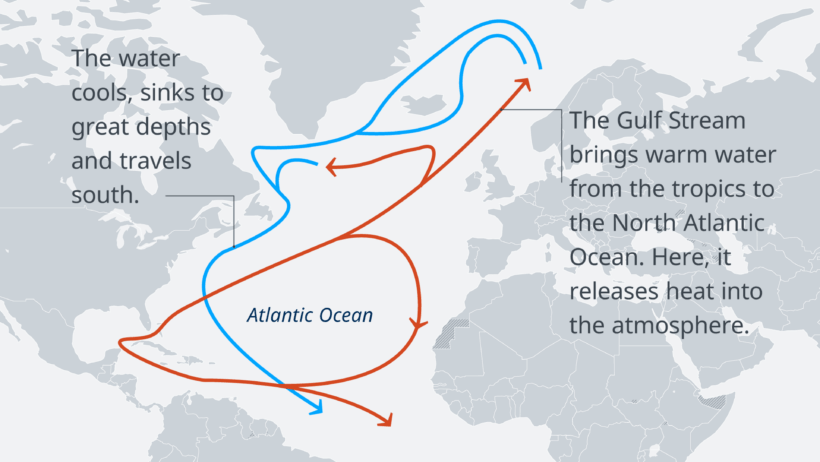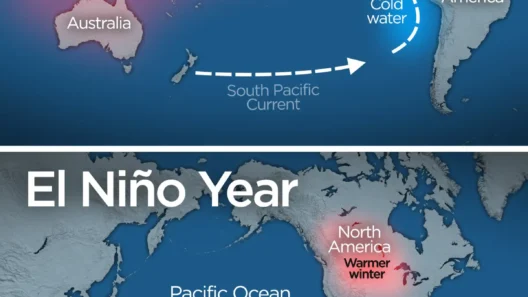The Gulf Stream, a formidable ocean current that traverses the Atlantic, has nurtured countless climatic phenomena that dictate global weather patterns. This intricate system has long been the backbone of temperate weather in Western Europe and the Eastern United States. However, recent revelations suggest that the Gulf Stream is at its weakest point in 1,600 years. What implications does this hold for our planet, and can it be envisioned as a double-edged sword for our climate? Plunging deeper into the enigmatic workings of this current yields perplexing insights into how our warming world stands poised for emotional upheaval.
The Gulf Stream plays a critical role in what is termed “thermohaline circulation,” a key component of Earth’s climate system. This current originates in the Caribbean Sea, sweeping towards the North Atlantic, and ultimately influencing climate across continents. As warmer water flows northward, it dissipates heat into the atmosphere, thereby elucidating the temperate conditions enjoyed by various regions. Thus, the Gulf Stream acts as a finicky thermostat regulating not just temperature, but also impacting precipitation patterns and storm systems.
However, as problems proliferate in our ecological systems, the stability of the Gulf Stream is being called into question. With increasing temperatures attributed to anthropogenic climate change, the delicate balance that fuels the current is shifting unpredictably. As polar ice melts, the resultant influx of freshwater into the North Atlantic dilutes the saline waters crucial for sinking cold currents, thus stymieing the engine that drives this significant waterway.
The interaction of these components begs the question: “Will our warming winds result in more erratic weather patterns than we have ever witnessed?” As the Gulf Stream falters, the implications are nothing short of alarming. The disruption could lead to more frequent and severe weather events—hurricanes, prolonged droughts, and torrential rainfalls—upending ecosystems and affecting human life. A warmer atmosphere holds more moisture, which can intensify storms. Storm surges and flooding become exacerbated in coastal zones, leading to dire consequences for millions of inhabitants who have settled near shorelines.
What’s more, regions that have historically enjoyed mild weather may grapple with unexpected frigid spells, as shifting wind patterns dance chaotically about. The northeast coast of the United States, already troubled by variable weather patterns, might become increasingly susceptible to ice storms and cold fronts. This scenario presents a multifaceted dilemma. Can we architect a climate construct that fairly balances preparation, resilience, and adaptation?
Food security is another thread intricately woven into this complex tapestry. As climate patterns morph, agricultural zones will be disrupted, affecting crop yields and livestock. A thorough examination of this impact reveals an intricate chain reaction; if the Gulf Stream’s subtler guidance is stripped away, one can expect disruption to agricultural cycles not only in North America but across the globe. The domino effect is staggering: increased pestilence, altered growing seasons, and unforeseen ecological challenges will ignite new dilemmas for farmers and those who rely upon their produce.
Indeed, understanding the Gulf Stream leads us to confront a harrowing reality: the government, agricultural sectors, and communities must prepare for a possible new normal. As we face the potential for agricultural volatility, an agile and innovative response becomes imperative. Are we malleable enough to adapt our agricultural practices as climate necessitates? Will we harness advancements in technology and sustainable practices to safeguard against emergent challenges? The answers may very well determine whether we can dodge the full brunt of this environmental tempest.
Additionally, the socio-economic ramifications cannot be overlooked. Regions reliant on tourism, fisheries, and agriculture—such as the Caribbean and parts of Western Europe—may find themselves beleaguered by instability. As communities strive to adapt, the socioeconomic fabric may fray, leading to increased tensions over dwindling resources. What measures are societies prepared to embrace in the face of such unpredictability? This question propels us to examine our values and commitments toward one another and future generations.
Given the current trajectory of environmental legislation, one must also ponder—are we prioritizing climate change mitigation deeply enough? The weak state of the Gulf Stream serves as a clarion call for policymakers, scientists, and citizens alike. A united front becomes essential to rally behind renewable energy, sustainable agriculture, and preserved ecosystems. Investing in research to bolster climate resilience presents an opportunity to innovate solutions that may re-establish the equilibrium we inadvertently jeopardized.
It is clear that the Gulf Stream’s health is intrinsically linked to the planet’s environmental fate. As winds warm and weather transforms, the call to action becomes urgent. How will we confront the uncertainties that lie ahead? The trajectory toward a realistic and sustainable future hinges upon our recognition of the inherent interconnectivity of the climate system. The future is indeed unpredictable—yet by fostering resilience and adaptation, we may mitigate the consequences of such disruption. The journey to this realization may be arduous, but it is a path we must traverse to fortify our collective fortitude against the unknown storms of warming winds and weather disruption.





